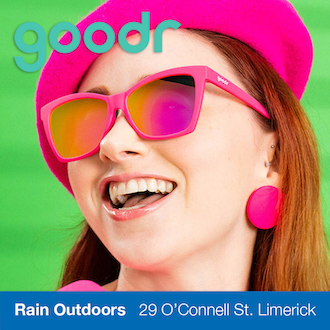
IRISH Guide Dogs for the Blind in Cork has been training dogs to help blind and vision impaired people reach life-changing new levels of independence and mobility since 1976, Kathy Masterson finds out more about the organisation and meets some local guide and assistance dogs and their owners.

PAM Young from Killaloe-Ballina got her guide dog Callie, a Labrador-retriever, two years ago. As well as granting Pam a new level of independence, Callie has become a very important member of the family, alongside Pam’s husband Brett, their children Zoe (10), Conor (8) and their terrier Poppy.
Pam, who has been blind since she was a toddler, says she always wanted a guide dog, but wanted to wait until her children were old enough to understand the difference between a pet and a working dog.
“It was always in the back of my mind that I wanted to get a guide dog, so once the kids were older I thought ‘It’s either now or never’. I didn’t want to leave it too long. It was nice to be able to do it when the kids were still kind of small so I would be able to go down to the shops with them and stuff,” she explained.
Before embarking on her three-week live-in intensive training with Callie at the Irish Guide Dog centre in Cork, Pam first had to make sure that she was the right dog for her.
“You go to Cork first for what’s called a matching visit and you spend an hour with the dog and you go for a walk. You and the instructor decide between you whether the dog suits you and then you’re given the date to start your training.
“They’re very good at matching people to the right dog. I’m quite small so I wasn’t going to get a very big dog. They look at speed as well, how fast you walk, and personality. Callie is quite a sensitive dog, which is why they matched me with her. I don’t think I would have been able for a very confident dog,” said Pam.
During her three weeks training in Cork, Pam and her instructor walked around the city and suburbs with Callie, and practiced getting on and off buses and trains, as well as spending time learning the various guide dog commands.
Pam also had to become familiar with a number of routes in her own locality before taking Callie home.
She told the Limerick Post: “Before I got the dog I had to go out with my long cane, which personally I hate, and prepare some routes. With the cane you’re a lot slower, well I was anyway, and not as confident as with the dog.
“With the dog I go a lot further than I ever would have with the cane. For me I felt more like I had a disability when I walked with the cane than I would walking with the dog. People come up more and talk to you as well when you have the dog.”
Pam’s children took to Callie straightaway; they know not to distract her when her harness is on, but once the harness comes off, it’s playtime.
“The kids are mad about her. Conor will sit on the floor with her and Callie will lie with her head on his lap, it’s lovely.
“When she hasn’t got a harness on she’s basically a normal dog. You still have to follow certain rules, like you can’t give them food from the table. Other than that she’s allowed to play and be a normal pet dog when she’s not working, which is nice,” says Pam.
Fortunately, Pam and Callie have so far received a warm welcome when visiting shops and cafes, however they can encounter other obstacles when out and about.
“Cars parking on footpaths is a real nuisance because sometimes there might not be enough room to get past so you’d have to go out on the road, which is dangerous. Loose dogs are a big problem, because even if a dog is not aggressive, they might still distract Callie. She could end up bringing me the wrong way and things like that.
“Around here the lack of tactile crossings is also a problem. I wrote to Minister Alan Kelly about it but I had an email recently from him saying there was no funding at the moment for them, which is really annoying.”
Having Callie has been a life-changing experience, not only for Pam, but for the whole family, as it means she can now go for walks with her children on her own.
Pam concluded: “I’m more confident now I have Callie. Just being able to go out on my own is brilliant, even with the cane I wouldn’t really have gone out on my own. It’s great being able to grab her harness and say ‘let’s go for a walk’, and not have to depend on having other people with me. Being able to go to the shops with the kids on my own, something I never thought I’d be able to do, that’s really nice.
“I couldn’t imagine not having Callie now. I couldn’t go back to not having a guide dog. You have a very close bond with a guide dog. I know people have a close bond with their pets, but with a guide dog it is a bit different in that they have to guide you places safely and you have to really trust them.”
A Special Bond

BEFORE Stephanie Schmid’s son Darragh (7), who has autism, received his assistance dog Ulla in 2013, leaving the house was always a challenge for the Limerick family as Darragh had a habit of running away, putting himself in danger from oncoming traffic.
Now, Ulla has taught Darragh to look out for traffic, and his social skills have come on in leaps and bounds thanks to the companionship of his faithful furry friend.
“Before we got Ulla going outside would have been a bit of a nightmare, I would always have been quite anxious because of Darragh’s tendency to bolt. If he got a fright or anything he would just run away, so I was always hyper aware of that and had to keep my hands on him all the time. Now, we can attach him to Ulla with the attachment lead and he can’t run any further than the lead, so I know he’s safe all the time.
“The dog always stops when we’re at a kerb, so now even when we go out without the dog Darragh will always stop too. Ulla has just made Darragh a lot more aware of traffic,” Stephanie told the Limerick Post.
Darragh also previously struggled with initiating conversations when he was out and about, but now he will tell anyone who will listen all about his special dog.
Stephanie explained: “Darragh would never start a conversation; he wouldn’t understand why you would stop and stand talking to somebody on the street. He would pull at me and try to get away. Now, he instigates the conversation, he loves telling people all about the dog. It gives him something to talk about.
“He’s also much more inclined to go outside now. Before he would be anxious about leaving the house, but now he’ll say ‘It’s time for Ulla’s walk’, so it really gets him out. It’s opened up a whole new world for him.
“Before we got Ulla he would even have been afraid of dogs, he’d always cover his ears if he heard a dog barking. Now he doesn’t take any notice. It’s made it much easier for him to be around other dogs.”
As well as keeping Darragh safe and helping with his social skills, Ulla and Darragh have also developed a close bond and have a lot of fun playing together at home.
“There’s such a special bond between Darragh and the dog, they get on great, they love playing together. Even myself, I have a special bond with the dog too because I know he’s looking after Darragh,” said Stephanie.
Stephanie believes that having an assistance dog, or even a regular pet dog, brings enormous benefits for children on the autism spectrum, and believes that as many autistic children as possible should be given the opportunity to have an assistance dog.
She concluded: “It would be fantastic if every child with autism could have an assistance dog. I’ve seen the benefits of it first hand. When I meet someone who has a child with autism the first thing I ask is have they applied for an assistance dog. The applications are closed now so I’d always recommend that they just even get a dog as a pet, because they definitely do help.”
Puppies in Training

Picture: Keith Wiseman
IRISH Guide Dogs for the Blind is always seeking Limerick people who wish to become volunteer puppy walkers.
A puppy walker’s job is to look after a puppy from about eight weeks to one year old, to socialise it and give it basic training so it will be ready to return to the centre in Cork to begin its intensive guide dog training.
Anyone can apply to be a puppy walker, however there needs to be an adult at home full time, and puppies cannot be placed in homes where there are children under five years of age.
Joan Heffernan from Limerick is currently looking after her third puppy, a Labrador-retriever cross called Vixi.
“Vixi is my third dog. She’s a very clever, very energetic dog. The dogs all have very different personalities. My first dog Hannah was a very active dog. She was very clever, she was able to reach the door handle and open it; she was an escape artist, she became a guide dog.
“My last dog Echo was the most adorable dog you could ever have. Everyone fell in love with her. She had an unbelievable way of drawing people to her. She’s going to be an assistance dog and whoever gets her will be extremely lucky because she’s a really beautiful dog,” said Joan.
Prospective guide dogs and assistance dogs need to become used to a range of different situations and noises, as well as being around lots of different people.
To prepare them for this, their training and socialisation begins from day one, and Joan takes Vixi with her everywhere.
She explained: “You get the puppies when they’re very small, about eight weeks old, and they’re very cute. You can’t do an awful lot with them until they’re a bit bigger. You have to socialise them from the word go; I bring them everywhere with me, into coffee shops, the supermarket, into the city or the shopping centre. You have to get them used to being out and about and used to people and traffic and different sounds. The idea is to make them very sociable and not afraid of anything.”
Puppy walkers are supported every step of the way by Irish Guide Dogs for the Blind’s puppy walking supervisors, who keep in regular contact with the volunteers, assisting them with puppy training and monitoring the puppy’s progress.
“It’s great fun, there’s a very social side to it too. Irish Guide Dogs in Cork keep in contact the whole time. The representative from Irish Guide Dogs comes up once a month to do training sessions with Vixi; you have very good back-up. They’re very proud of their dogs and very careful with who they go to. You are assessed before you’re given a dog, they do a homecheck and meet your family and ask why you want to have a puppy. You have to get Garda clearance before you’re given a dog as well,” said Joan.
Joan says she would recommend volunteering as a puppy walker to anybody who has the time to commit to it because of the sense of achievement she feels when the puppies she has cared for go on to help someone with a disability.
“It’s great fun having the dog. It’s a lovely thing to do, you feel great when you look after a dog and then you hear that they end up being a guide dog or an assistance dog. It gives you a great buzz, it’s fantastic, they’re all really beautiful dogs.”
About Irish Guide Dogs for the Blind

Its high-profile patrons and supporters include soccer legend Roy Keane, and fellow Cork native and Olympic athlete Sonia O’Sullivan.
The non-profit organisation provides life-changing services to people who are blind or visually impaired and families who have children with autism.
Irish Guide Dogs for the Blind was the first organisation in Europe to launch an assistance dog scheme for children with autism in 2005, unfortunately it had to close applications for assistance dogs in 2012, such was the high demand for the service.
The organisation breeds all of its own pups and uses a variety of breeds as guide and assistance dogs, such as Labradors, German shepherds, golden retrievers and even labradoodles – a Labrador and poodle cross.
Despite its name, Irish Guide Dogs for the Blind also does a lot of work that does not involve dogs, such as providing training courses in mobility and independent living skills for adults and young people who are blind or visually impaired.
The organisation also works to raise awareness of the rights of guide dog and assistance dog owners in the service and transport industries, and liaises with local authorities and government departments to promote better accessibility for blind and vision impaired people in public places.
Irish Guide Dogs for the Blind is hosting a ‘Go Walkies for Guide Dogs’ five-kilometre walk in The University of Limerick campus this Sunday, June 14 at 12pm, meeting at the UL Pavillion. For more information, go to www.guidedogs.ie










